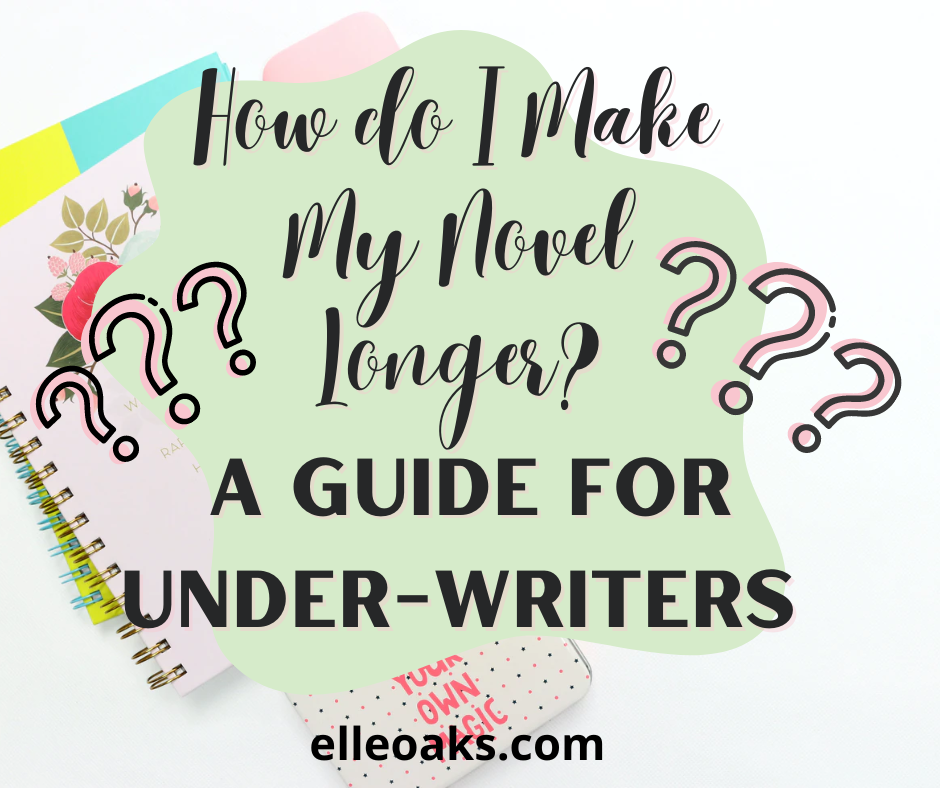Plotter versus pantser is the tale as old as time. But what about over-writers versus under-writers? Today we’ll take a look at how to up your game as an under-writer!

As a writer, you’ve probably googled “How long should my novel be?”. The answers vary from site to site but ranges can be found to help one get an idea. Each genre differs. So when checking for expected word counts be sure you’re checking in your genre and with the target audience in mind.
If you are self-publishing or an already acclaimed author, word count isn’t something you need to worry too much about. While self-publishing should pay attention to their word count, it’s more so the audience expectation you’ll want to target rather than a publishing house’s expectation.
Typically, anything longer than 50,000 words is considered a novel. (There are exceptions for middle grade audiences). Adult novels, especially in the sci-fi and fantasy genres, tend toward a larger word count. This is because these two genres need more worldbuilding and explanations due to typical conflicts in these stories. Therefore, people feel if the word count is too low that your novel is probably incomplete or underdeveloped.
I am an under-writer.
This means I tend toward a skeleton first draft and then flesh out the details in my subsequent edits. When writing down the story, I don’t like to add fluff and purple prose. I get down to it. Keep it brief. Keep it concise. I try to make every single word matter.
So, when going back through the draft, I tend to build up the characters and world. First draft focuses heavily on the plot and conflict. Second draft is determining what could be added to develop character and world better. This can mean adding sentences here and there. Or it can mean adding in entire chapters.
Questions for the under-writer
To determine what is needed, ask a couple of questions during your read through of the first draft:
Will the reader be able to envision the world I’m creating?
Am I lacking details to give them an accurate description and help add to the imagery?
Are my characters flat or static throughout the story?
Are the relationships between the characters evident in their interaction?
Then there’s also the problem when you are writing a series. Is your first book just setting up for the exciting stuff? Or does it stand alone? I found that I did this with my very first drafted novel. The first book was like setting up the chessboard. It built and built tension and then just ended. The actual game of chess came in the second book. This is unfair to the reader. They expect a certain amount of resolution or conclusion to some of the conflicts presented in the novel. If you do not satisfy that hunger, they are less likely to pick up the second book.
Each book in a series should be able to stand alone. It should create certain conflicts that are resolved by the end. Open ended conflicts are fine to carry into the next, but leaving all conflicts open isn’t satisfying for anyone.
In this case, you may need to add chapters or other conflicts into your story for the sole purpose of resolving some of them by the end. Another reason why adding possible conflict helps is because often we underwrite because the story is not fully developed. Maybe you didn’t outline. Maybe you were so excited to get to the end your mind jumped straight to it.
Sometimes, I find that I daydream about the idea so much that there are ideas I develop in my head and forget to write down. The story fleshes out fully in my imagination but when I do the reread with the mindset of reading the novel for the first time, I don’t understand how I made certain connections.
Or even more critical, I realize that I’ve completely undermined any tension I had attempted to build in the beginning.
What I did to solve my under-writing
In my first drafted novel, I spent several chapters outlining a civil war in my fantasy world. Supposedly violence breaks out in the town where my protagonists are, but they don’t find any conflict. So why would I introduce the civil war to not even mention it later when most applicable? That’s a good question and pinpoints a problem in storytelling. It didn’t make sense. Being a good writer and storyteller means using conflict to boost tension. If you are boosting tension with conflicts that never come to pass, the reader will feel slighted and disappointed.
To fix this, I added in chapters with my characters running into this conflict that I had presented to them earlier. To reduce the need of rewriting the entire ending, I ensured that the characters surmounted the conflict before getting back to where I left off. No timeline change was needed. No major edits after the fact. And on the reread, everything made so much more sense and the character development and worldbuilding those chapters added to the overall story was just what the story needed.
Conclusion
Under-writing is not a problem. It has its strengths and weaknesses. Hopefully these tips will help you add to your novel, increasing its length in a practical and fun way. Readers don’t want the story to stop before it’s barely begun. They also don’t want to feel ripped off when the story misses the beats of building characters, setting, and conflict.
Ask yourself these questions, and you can make your story blossom into life!
Did I miss something? Let me know in the comments below what you think is the most question an under-writer should be asking themselves! Share your tips on how you flesh out your second draft!
Like this post? Share on your socials!
Questions or ideas about future posts? Contact us on our form! Click here.

